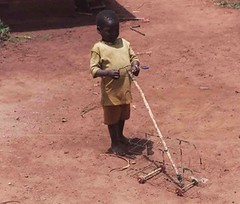
Photo courtesy of Bergey. Oct 26 2006 Dedication of the cell phone base station site in Laisamis, Kenya Africa.
AfriGadget appears to be on a roll with wind power, so lets continue the wave shall we?
The company WinAfrique designs and builds hybrid wind and diesel turbine systems for powering cell phone base stations. Kenya’s biggest wireless companies Safaricom and Celtel have contracted with WinAfrique.
…Safaricom contracted with Winafrique Technologies in Nairobi to design and supply pilot wind/diesel hybrid systems at three very remote base stations. The systems consisted of a Bergey 7.5 kW turbine on a 24 m (80 ft) SSV tower, sealed batteries, and an inverter. These sites were installed and monitored for one year. The results showed excellent reliability and diesel fuel savings of 70-95%. Based on these positive results, Safaricom has contracted for six more sites, and has many other wind/diesel sites in the planning stage.
Hybrid systems that utilize renewable energy such as wind and solar are making it possible to extend wireless service in remote areas that are not connected to grid power. You can read more about Safaricom’s use of wind powered cell phone base stations, and more here about Celtel’s.




 The image is from Kevin Kelly’s site, it is of a wire toy made by a child in Uganda.
The image is from Kevin Kelly’s site, it is of a wire toy made by a child in Uganda.